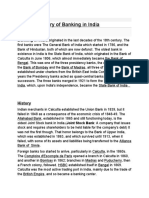Evaluation of Indian Financial System
Evaluation of Indian Financial System
Uploaded by
anon_686738527Copyright:
Available Formats
Evaluation of Indian Financial System
Evaluation of Indian Financial System
Uploaded by
anon_686738527Copyright
Available Formats
Share this document
Did you find this document useful?
Is this content inappropriate?
Copyright:
Available Formats
Evaluation of Indian Financial System
Evaluation of Indian Financial System
Uploaded by
anon_686738527Copyright:
Available Formats
EVOLUTION OF INDIAN FINANCIAL SYSTEM
Banking in India originated in the last decades of the 18th century. The first banks were The General Bank of India which started in 1786, and the Bank of Hindustan, both of which are now defunct. The oldest bank in existence in India is the State Bank of India, which originated in the Bank of Calcutta in June 1806, which almost immediately became the Bank of Bengal. This was one of the three presidency banks, the other two being the Bank of Bombay and the Bank of Madras, all three of which were established under charters from the British East India Company. For many years the Presidency banks acted as quasi-central banks, as did their successors. The three banks merged in 1921 to form the Imperial Bank of India, which, upon India's independence, became the State Bank of India.
The first entirely Indian joint stock bank was the Oudh Commercial Bank, established in 1881 in Faizabad. It failed in 1958. The next was the Punjab National Bank, established in Lahore in 1895, which has survived to the present and is now one of the largest banks in India. The period between 1906 and 1911, saw the establishment of banks inspired by the Swadeshi movement. The Swadeshi movement inspired local businessmen and political figures to found banks of and for the Indian community. A number of banks established then have survived to the present such as Bank of India, Corporation Bank, Indian Bank, Bank of Baroda, Canara Bank and Central Bank of India. From World War I to Independence The period during the First World War (1914-1918) through the end of the Second World War (19391945), and two years thereafter until the independence of India were challenging for Indian banking. The years of the First World War were turbulent, and it took its toll with banks simply collapsing despite the Indian economy gaining indirect boost due to war-related economic activities. Post-independence In 1948, the Reserve Bank of India, India's central banking authority, was nationalized, and it became an institution owned by the Government of India. In 1949, the Banking Regulation Act was enacted which empowered the Reserve Bank of India (RBI) "to regulate, control, and inspect the banks in India." The Banking Regulation Act also provided that no new bank or branch of an existing bank could be opened without a license from the RBI, and no two banks could have common directors. However, despite these provisions, control and regulations, banks in India except the State Bank of India, continued to be owned and operated by private persons. This changed with the nationalisation of major banks in India on 19 July, 1969. The nationalisation of banks in India took place in 1969 by Mrs. Indira Gandhi the then prime minister. It nationalised 14 banks then. These banks were mostly owned by businessmen and even managed by them. Central Bank of India, Bank of Maharashtra, Dena Bank, Punjab National Bank, Syndicate Bank, Canara Bank, Indian Bank, Indian Overseas Bank,Bank of Baroda, Union Bank, Allahabad Bank, United Bank of India, UCO Bank,Bank of India. A second phase of nationalization of 6 more commercial banks followed in 1980. The stated reason for the nationalization was to give the government more control of credit delivery. With the second dose of nationalization, the GOI controlled around 91% of the banking business of India. Later on, in the year
1993, the government merged New Bank of India with Punjab National Bank. Liberalization In the early 1990s, the then Narsimha Rao government embarked on a policy of liberalization, licensing a small number of private banks. These came to be known as New Generation tech-savvy banks, and included Global Trust Bank (the first of such new generation banks to be set up), which later amalgamated with Oriental Bank of Commerce, Axis Bank(earlier as UTI Bank), ICICI Bank and HDFC Bank. This move, along with the rapid growth in the economy of India, revitalized the banking sector in India, which has seen rapid growth with strong contribution from all the three sectors of banks, namely, government banks, private banks and foreign banks. State Bank of India (SBI) is the largest bank in India. The bank traces its ancestry back through the Imperial Bank of India to the founding in 1806 of the Bank of Calcutta, making it the oldest commercial bank in the Indian Subcontinent. The Government of India nationalized the Imperial Bank of India in 1955, with the Reserve Bank of India taking a 60% stake, and renamed it the State Bank of India. In 2008, the Government took over the stake held by the Reserve Bank of India. SBI provides a range of banking products through its vast network in India and overseas, including products aimed at NRIs. The State Bank Group, with over 16000 branches, has the largest branch network in India. Associate banks The Subsidiaries of SBI till date State Bank of Indore State Bank of Bikaner & Jaipur State Bank of Hyderabad State Bank of Mysore State Bank of Patiala State Bank of Travancore Public Sector Banks There are total 27 public sector banks in India (As on 26-09-2009). Of these 19 are nationalized banks, 6(STATE BANK OF INDORE ALSO MEARGED RECENTLY) belong to SBI & associates group and 1 bank (IDBI Bank) is classified as other public sector bank
You might also like
- Sample Metered BillDocument2 pagesSample Metered BillYoutube Master100% (1)
- Pandemonium: The Great Indian Banking TragedyFrom EverandPandemonium: The Great Indian Banking TragedyRating: 5 out of 5 stars5/5 (4)
- Deposit Schemes Project ReportDocument59 pagesDeposit Schemes Project ReportAnu Joseph92% (13)
- Credit Repair Secrets ExposedDocument69 pagesCredit Repair Secrets ExposedJulian Williams©™89% (19)
- THFJ 50 Women in Hedge Funds 2011Document12 pagesTHFJ 50 Women in Hedge Funds 2011marianneowyNo ratings yet
- Complete Notes On Special Sit Class Joel Greenblatt 2Document311 pagesComplete Notes On Special Sit Class Joel Greenblatt 2eric_stNo ratings yet
- Banking Services Unit IDocument11 pagesBanking Services Unit IKrishna KumarNo ratings yet
- Banking in India Originated in The Last Decades of The 18th CenturyDocument5 pagesBanking in India Originated in The Last Decades of The 18th CenturycharadvabhavinNo ratings yet
- Chi Ranji ViDocument19 pagesChi Ranji ViPratik GosaviNo ratings yet
- Banking Unit 1Document33 pagesBanking Unit 1madhuNo ratings yet
- Banking in IndiaDocument8 pagesBanking in IndianisspartaNo ratings yet
- Banking in IndiaDocument7 pagesBanking in IndiaShrikant PawarNo ratings yet
- Banking in IndiaDocument52 pagesBanking in IndiaPerminder Singh KhalsaNo ratings yet
- Banking - 2 SemDocument25 pagesBanking - 2 SemShivajee SNo ratings yet
- Banking in IndiaDocument7 pagesBanking in IndiaLakshmi NagurNo ratings yet
- Banking in IndiaDocument14 pagesBanking in IndiaTushar DhaleNo ratings yet
- Banking in IndiaDocument7 pagesBanking in IndiaPramod ParthanNo ratings yet
- Banking in IndiaDocument6 pagesBanking in IndiaHarshit TopnoNo ratings yet
- Banking History For IbpsDocument101 pagesBanking History For Ibpskrishna21988No ratings yet
- Banking in IndiaDocument7 pagesBanking in IndiaAnkit JainNo ratings yet
- Banking in IndiaDocument23 pagesBanking in Indiapoojasangodkar2011No ratings yet
- Banking ProjectDocument22 pagesBanking ProjectAkhileshwar RaiNo ratings yet
- Early History: Banks (That Is With The Government of India Holding A Stake), 31 Private BanksDocument5 pagesEarly History: Banks (That Is With The Government of India Holding A Stake), 31 Private Banksp4priyaNo ratings yet
- Banking History of India PDFDocument5 pagesBanking History of India PDFtheuiquevishalNo ratings yet
- Banking in India in The Modern Sense Originated in The Last Decades of The 18th Century. Among The FirstDocument1 pageBanking in India in The Modern Sense Originated in The Last Decades of The 18th Century. Among The FirstvarunNo ratings yet
- Bankins System in India HistoryDocument9 pagesBankins System in India HistoryHappy SinghNo ratings yet
- Evolution of Banking in INDIADocument7 pagesEvolution of Banking in INDIAsakshi khushuNo ratings yet
- All AttachDocument10 pagesAll Attachkp93singhNo ratings yet
- History of Banking in IndiaDocument9 pagesHistory of Banking in IndiaVaidyanathan RavichandranNo ratings yet
- Banking in India Originated in The Last Decades of The 18th CenturyDocument16 pagesBanking in India Originated in The Last Decades of The 18th CenturyPinuRaoNo ratings yet
- Marketing ResearchDocument39 pagesMarketing ResearchHarpreet SinghNo ratings yet
- From Wikipedia, The Free Encyclopedia Jump To: ,: Navigation SearchDocument44 pagesFrom Wikipedia, The Free Encyclopedia Jump To: ,: Navigation SearchvitvikiNo ratings yet
- J&K BANK Final Project AadilDocument48 pagesJ&K BANK Final Project AadilzargarNo ratings yet
- About Banking IndustryDocument35 pagesAbout Banking Industrynagendra6391No ratings yet
- Bank of Bengal Bank of Bombay Bank of MadrasDocument6 pagesBank of Bengal Bank of Bombay Bank of Madras顾培正No ratings yet
- Industry Profile 1Document6 pagesIndustry Profile 1Jaya SuranaNo ratings yet
- History of Indian Banking IndustryDocument34 pagesHistory of Indian Banking IndustryRani AngelNo ratings yet
- Banking - Cat 1Document18 pagesBanking - Cat 1Asmitha NNo ratings yet
- Banking in IndiaDocument5 pagesBanking in IndiaGuru BaranNo ratings yet
- Bank IndustryDocument3 pagesBank IndustryShan KhanNo ratings yet
- Definition of BankDocument14 pagesDefinition of BankSuman RoyNo ratings yet
- Banking in IndiaDocument10 pagesBanking in Indialeblitzer_0No ratings yet
- Legal & Regulatory Aspects of Banking: Module - ADocument32 pagesLegal & Regulatory Aspects of Banking: Module - ASiva BantuNo ratings yet
- Banking in IndiaDocument7 pagesBanking in Indiakaushal5091916No ratings yet
- Project ReportDocument39 pagesProject ReportVishnu vinayNo ratings yet
- Industry Analysis of Banking SectorDocument20 pagesIndustry Analysis of Banking Sectorusefulthomas67No ratings yet
- History: Calcutta Allahabad BankDocument5 pagesHistory: Calcutta Allahabad BankRucha PilgaonkarNo ratings yet
- Banking in IndiaDocument16 pagesBanking in IndiaChirag GogriNo ratings yet
- Banking in India: Banking in India Originated in The Last Decades of The 18th CenturyDocument5 pagesBanking in India: Banking in India Originated in The Last Decades of The 18th CenturysaiyuvatechNo ratings yet
- Modernisation in Banking System in IndiaDocument47 pagesModernisation in Banking System in IndiaRupal Rohan Dalal100% (1)
- The General Bank of India Was Set Up in The Year 1786Document2 pagesThe General Bank of India Was Set Up in The Year 1786ANKIT SINGHNo ratings yet
- Gurvinder KaurDocument57 pagesGurvinder KaurDaman Deep Singh ArnejaNo ratings yet
- Sabarkantha District Central CoDocument47 pagesSabarkantha District Central Cohkpatel8121No ratings yet
- Banking in IndiaDocument6 pagesBanking in Indiasrinivas_vegunta9999No ratings yet
- Banking in IndiaDocument16 pagesBanking in IndiamukeshecgcNo ratings yet
- Union BankDocument35 pagesUnion BankNarendra MuppasaniNo ratings yet
- Finance ProjectDocument78 pagesFinance ProjectRuchi SharmaNo ratings yet
- Banking in IndiaDocument5 pagesBanking in IndiaRohan ChristianNo ratings yet
- Banking in IndiaDocument8 pagesBanking in IndiaRavi KumarNo ratings yet
- Industry ProfileDocument4 pagesIndustry Profilemoncloud9No ratings yet
- History: Banking in India Banking in India Originated in The Last Decades of The 18th Century. The First Banks Were TheDocument29 pagesHistory: Banking in India Banking in India Originated in The Last Decades of The 18th Century. The First Banks Were TheAvika SharmaNo ratings yet
- Banking Industry in India: Bank of Bengal Bank of Bombay Bank of MadrasDocument31 pagesBanking Industry in India: Bank of Bengal Bank of Bombay Bank of MadrassmitcseNo ratings yet
- A Comprehensive Guide of Early Paper Money of India (1770-1861 A.D.): (1770-1861 A.D.)From EverandA Comprehensive Guide of Early Paper Money of India (1770-1861 A.D.): (1770-1861 A.D.)Rating: 5 out of 5 stars5/5 (1)
- Banking India: Accepting Deposits for the Purpose of LendingFrom EverandBanking India: Accepting Deposits for the Purpose of LendingNo ratings yet
- Gema PowerpointDocument18 pagesGema PowerpointnanzNo ratings yet
- Risk Analysis, Cost of Capital and Capital BudgetingDocument10 pagesRisk Analysis, Cost of Capital and Capital BudgetingJahid HasanNo ratings yet
- Au Cases NSW NSWSC 2018 886Document48 pagesAu Cases NSW NSWSC 2018 886Michael SmithNo ratings yet
- FAR - 2017 AICPA Released Questions PDFDocument61 pagesFAR - 2017 AICPA Released Questions PDFAhmed50% (2)
- Jiblr 2005 20 10 535-540Document6 pagesJiblr 2005 20 10 535-540Santanu RoyNo ratings yet
- MT4i Internet Trade Mirror - ReceiverDocument23 pagesMT4i Internet Trade Mirror - Receivercasinoroyal005No ratings yet
- Suits For Breach of ContractDocument10 pagesSuits For Breach of ContractDharma TejaNo ratings yet
- Valuation Using MultiplesDocument21 pagesValuation Using MultiplesJithu JoseNo ratings yet
- FDNINFPRE000010032021080501Document1 pageFDNINFPRE000010032021080501aeiouNo ratings yet
- Liquidity Management in BanksDocument11 pagesLiquidity Management in BanksPoonam SannakeNo ratings yet
- Report To Start IndustryDocument33 pagesReport To Start IndustryPuneet SinghNo ratings yet
- Dumalaon Cristina PDocument3 pagesDumalaon Cristina PBàd MiyonesNo ratings yet
- A Study On Performance Evaluation of SmallDocument22 pagesA Study On Performance Evaluation of Smalljhanu jhanuNo ratings yet
- Fundamentals of Partnership QuestionsDocument1 pageFundamentals of Partnership Questionsvandu.rekhiNo ratings yet
- Financial Planning and ForecastingDocument16 pagesFinancial Planning and ForecastingAzain UsmanNo ratings yet
- Taxation and Fiscal PolicyDocument3 pagesTaxation and Fiscal PolicyBanana CrazyNo ratings yet
- Fundamentals of Accounting An IntroductionDocument20 pagesFundamentals of Accounting An IntroductionjomarNo ratings yet
- Baumols TheoryDocument35 pagesBaumols TheoryAman Singh Rajput100% (1)
- Annexure-4-Approval Letter AxisDocument2 pagesAnnexure-4-Approval Letter Axissohanpatra000No ratings yet
- Siemens Limited Annual Report 2013Document95 pagesSiemens Limited Annual Report 2013Akshay UkeyNo ratings yet
- China Sportswear: Sporting ChallengeDocument52 pagesChina Sportswear: Sporting ChallengeKylie ChanNo ratings yet
- Assignment On Financial Accounting & AnalysisDocument7 pagesAssignment On Financial Accounting & AnalysisArko RoyNo ratings yet
- Case Study Grameen BankDocument7 pagesCase Study Grameen BankkatnavNo ratings yet
- Ctryprem Apr 20Document179 pagesCtryprem Apr 20MumTagguRmgNo ratings yet
- Global Invacom Appoints Gordon Blaikie As Chief Operating OfficerDocument2 pagesGlobal Invacom Appoints Gordon Blaikie As Chief Operating OfficerWeR1 Consultants Pte LtdNo ratings yet
- Memorandum of Agreement DREAMLIFE FARMDocument5 pagesMemorandum of Agreement DREAMLIFE FARMDennisSaycoNo ratings yet

























































































